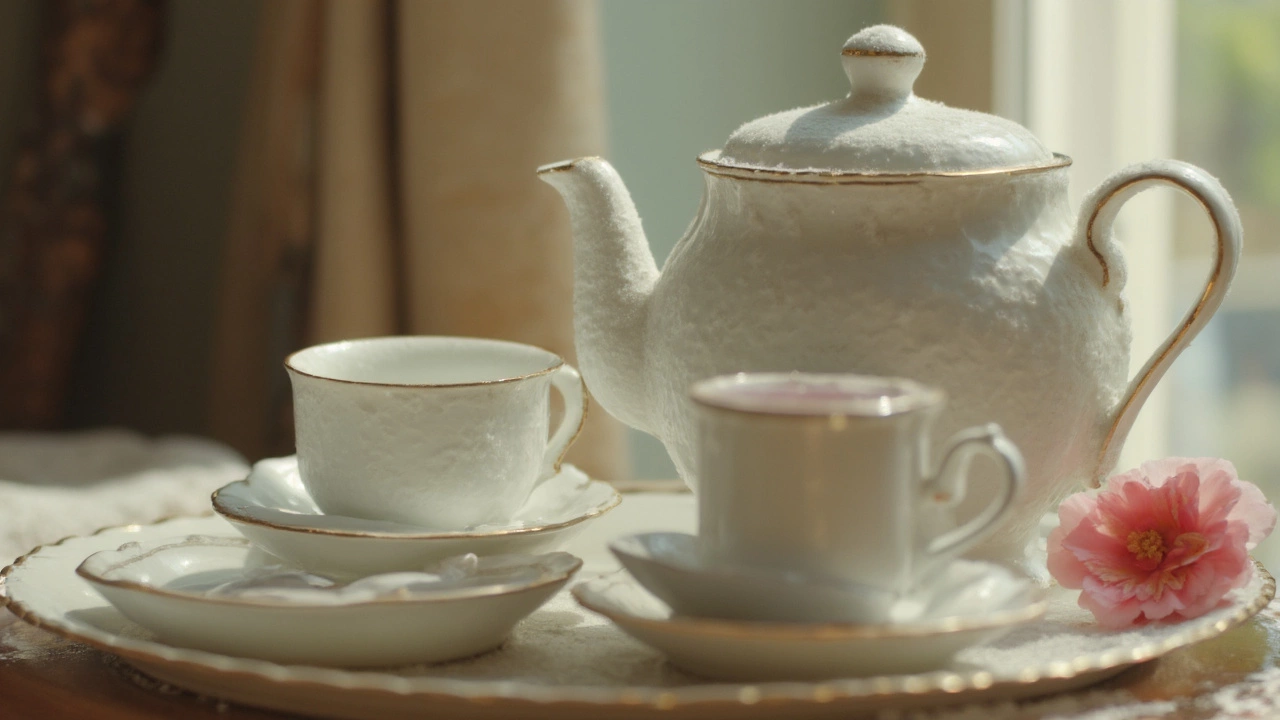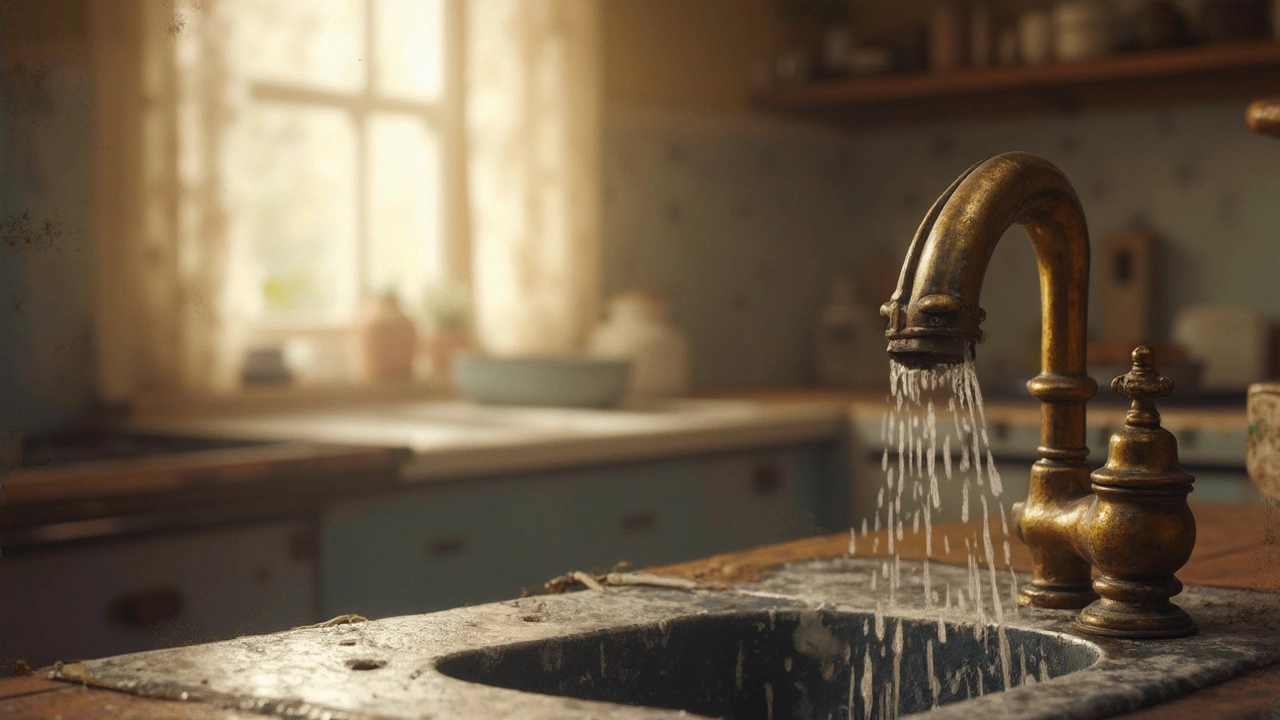If you've ever spotted a white, crusty buildup on your tap or kettle, you've met limescale. It's not just an aesthetic issue; it can actually affect the performance of your appliances. So, knowing how to deal with it is pretty handy, especially if you're moving out of a rented place and want everything to look spotless.
Limescale is more likely to rear its ugly head in homes with hard water. What’s hard water, you ask? It’s water with high calcium and magnesium content. These minerals are the culprits behind that stubborn chalky residue. While it might seem harmless, over time, limescale can cause serious issues like clogging pipes and reducing energy efficiency.
Spotting limescale is not that tricky. Think white or greenish crust around your faucets, showerheads, and even in your toilet bowl. It can also show up inside appliances that use water, like kettles, washing machines, or dishwashers. Knowing what and where to check is a big step toward achieving a limescale-free home.
- What is Limescale?
- Where to Find Limescale
- Why Limescale Forms
- Effects of Limescale
- How to Remove Limescale
- Preventing Limescale Build-Up
What is Limescale?
Limescale is that pesky white or greenish-grey crust you find on taps, showerheads, and inside kettles. It's primarily made of calcium carbonate, a mineral that comes from hard water. When hard water flows through your home's plumbing, it's carrying with it high levels of calcium and magnesium.
As the water heats up or evaporates, these dissolved minerals solidify and stick to surfaces, creating the limescale build-up we all dread. It’s especially common in areas where the water supply is rich in these minerals — basically, if you live in a hard water zone, you've got a front row seat to the limescale show.
Understanding Hard Water
Hard water isn’t a weird experiment from a high school lab; it’s a natural occurrence. Water becomes 'hard' when it picks up minerals from rocks and soil, especially limestone, as it journeys through the ground to your taps. This means that seemingly safe water can leave behind mineral deposits that make cleaning a real chore.
A quick look at a kettle or coffee maker with limescale buildup shows how it can even sneak into your morning routine. The white, chalky residue can affect how quickly these appliances heat, impacting energy efficiency.
Spotting the Signs
Identifying limescale isn’t rocket science. If you're seeing crusty deposits on faucets or that classic ring around your toilet bowl, it's limescale knocking at your door. For appliances, open up the lid or look inside, and you'll find those tell-tale deposits, especially near heating elements.
| Water Hardness | Calcium Content (mg/L) |
|---|---|
| Soft | 0-60 |
| Moderately Hard | 61-120 |
| Hard | 121-180 |
| Very Hard | 181 and above |
So, having hard water might not be the end of the world, but it can lead to an ongoing battle with limescale. Keep an eye out for these signs, and you’ll be better equipped to tackle it before it takes over your home.
Where to Find Limescale
So, where exactly does limescale tend to hang out in your house? If you've got hard water, chances are you'll find it in a few key spots.
Common Spots for Limescale
The most common place is around water fixtures. Check your faucets and showerheads – if they're not sparkling, limescale could be the reason. This crusty nuisance loves to cling to anything that water flows over regularly.
Have a kettle or an old coffee maker? Peek inside, and you'll probably see a layer of white scales. It's sneaky like that and can hide in places you wouldn’t think to look.
Bathrooms and Kitchens
In the bathroom, limescale is likely to colonize on taps, tiles, and in the toilet bowl. In the kitchen, it often settles inside devices like dishwashers and washing machines, affecting their performance over time. Even your pots and pans aren't safe!
If you've got a glass shower door, watch out for the white streaks and cloudy glass. Limescale loves making home there, too. Keeping these spots clean is essential if you're wrapping up end of tenancy duties.
Surprising Limescale Havens
Would you believe the humble iron could also fall victim? Limescale can settle inside the reservoir, causing blockages and reduced steam output. Anytime water is involved, limescale might be lurking.
Lastly, take a good look at your heating elements, like the rods in your water heater. Even though they’re hidden away, they aren’t immune to limescale.
Knowing where to spot limescale simplifies the task of dealing with it effectively. So, make sure you check these usual hotspots and keep your home running like a well-oiled machine.
Why Limescale Forms
Limescale forms thanks to the minerals in hard water. When water evaporates, it leaves behind calcium and magnesium deposits, which then crystallize and form that pesky, white crust we know as limescale.
Hard water is the real villain here, and it's common in many parts of the world, including the UK. It's estimated that over 60% of homes in the UK have hard water. And you know what that means—a higher chance of facing limescale issues.
How Hard Water Leads to Limescale
So, how exactly do these minerals in water become a problem? When you heat hard water, the calcium and magnesium dissolve less effectively. As the water cools, the dissolved minerals start sticking to surfaces and crystalizing. That's why you often see limescale in kettles and boilers.
Impact on Household Appliances
Limescale isn’t just an eyesore; it can impact your household cleaning efforts, too. Over time, limescale builds up, decreasing the efficiency of appliances that use water like kettles and dishwashers. Imagine your kettle taking longer to boil or your dishwasher using extra energy. Yeah, that’s all because of limescale. Not to forget, it can also clog pipes, causing water flow problems.
Factors Contributing to More Limescale
Several factors can increase the odds of limescale formation:
- High Water Temperature: The higher the temperature of the water, the quicker limescale forms.
- Standing Water: Letting water sit, especially in appliances, provides ample time for mineral deposits to accumulate.
- Poor Ventilation: In areas like bathrooms, where moisture is high, lack of ventilation can make conditions ripe for limescale build-up.
Understanding these factors can help you get ahead of limescale problems, making your end of tenancy cleaning that much easier.

Effects of Limescale
Limescale isn't just an eyesore around the house—it's a genuine troublemaker. Let's dive into what makes this chalky fiend so pesky.
Appliance Efficiency Drop
First up, limescale can seriously bog down your appliances. Think kettles and dishwashers; they just don’t work as efficiently with limescale nagging inside. The build-up acts like insulation, meaning your kettle will take longer to heat water, using more energy and ultimately increasing bills.
Plumbing Woes
Limescale isn't shy about clinging to pipes either, gradually narrowing them and restricting water flow. If things get nasty, you might need a plumber to fix those limescale-choked pipes. It’s a case of prevention being cheaper than the cure.
Potential Damage
Beyond just the aesthetics of your sink and taps, over time, limescale can cause wear and tear. Faucets may drip, showerheads clog, and eventually, the look of your bathroom degrades, which isn't great if you're nearing an end of tenancy inspection. No one wants those extra charges.
The Cost Factor
Dealing with limescale effectively also impacts your wallet beyond basic cleaning. If left unchecked, it can increase the need for repairs or even replacements. Those pennies saved can quickly add up when you regularly manage limescale. A little preventative maintenance can mean fewer unexpected costs down the road.
Interestingly, a study from the Water Quality Association found on average, maintaining appliances in limescale-prone areas can add an extra 25% to household task times—a chunk of your day that nobody wants to surrender. Clearly, keeping on top of it isn’t just good for your stuff; it's good for you too.
How to Remove Limescale
Dealing with limescale can feel like an overwhelming task, but it's totally manageable with the right approach. Whether you’re scrubbing for an end of tenancy inspection or just giving your home a refresh, here are some practical ways to tackle limescale.
Using Natural Cleaners
Before you reach for harsh chemicals, give natural solutions a go. They’re not only eco-friendly but also effective on those stubborn mineral deposits.
- White Vinegar: Soak a cloth in white vinegar and wrap it around the area with limescale. Leave it on for a few hours, or overnight if needed, and then scrub off with a brush.
- Lemon Juice: The acidity in lemon juice cuts through limescale. Apply directly or mix with water for a quick spray solution. It also leaves a fresh scent, so that's a bonus.
Commercial Limescale Removers
If the natural route isn’t cutting it, there are plenty of commercial limescale removers. These are specially formulated to dissolve limescale quickly.
- Read the instructions on the label carefully.
- Ensure proper ventilation when using these products.
- Wear gloves to protect your skin.
Avoiding the Return of Limescale
Once you’ve tackled limescale, keeping it at bay involves a bit of ongoing effort. Drying surfaces after use and regular maintenance with vinegar or lemon juice helps prevent build-up.
| Appliance | Recommended Cleaning Frequency |
|---|---|
| Faucets | Weekly |
| Kettle | Monthly |
| Showerhead | Every Three Months |
Remember, staying on top of the clean can save you from scraping off persistent limescale later on. So, next time you notice that chalky look, you’ll know how to keep it under control without breaking a sweat.
Preventing Limescale Build-Up
So, how do we keep limescale out of our homes for good? Lucky for us, there are some straightforward tricks to prevent limescale build-up. First up, reducing hard water’s impact is key. Installing a water softener can do wonders. It swaps the calcium and magnesium ions with sodium – kind of like magic! This not only helps with lessening limescale but also makes your water better for cleaning and bathing.
Other than that, regular maintenance goes a long way. Give your household appliances a routine clean. A little vinegar or a specific limescale cleaner can keep things in check. Let’s walk through some steps:
- Monthly Cleaning: Descale your kettle and coffee machine using a mix of equal parts vinegar and water. Just run this through where water usually goes. Easy!
- Faucet Care: For taps and showerheads, soak a cloth in vinegar, wrap it around, and let it sit for a couple of hours. Then wipe away the loosened residue. It’s oddly satisfying.
- Toilets: Pour about a cup or two of vinegar into your toilet once a month. Let it sit overnight and scrub in the morning. Simple, right?
If you’re a fan of tech, you might want to look into electronic descalers. They’re gadgets that emit electronic frequencies to prevent minerals from sticking together and forming limescale. Neat, huh?
Finally, for landlords or those doing end of tenancy checks, creating a checklist of these preventive measures can encourage tenants to keep up with them. A clean slate for everyone!
